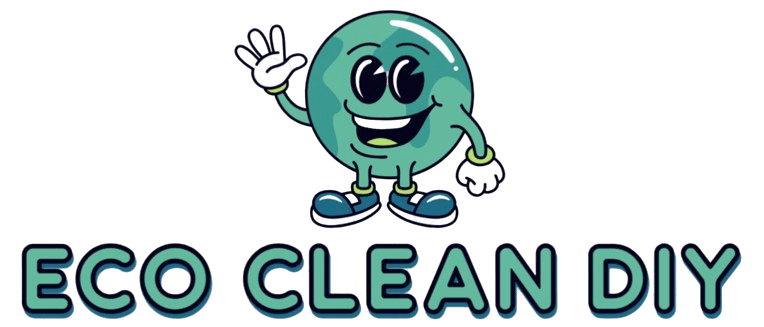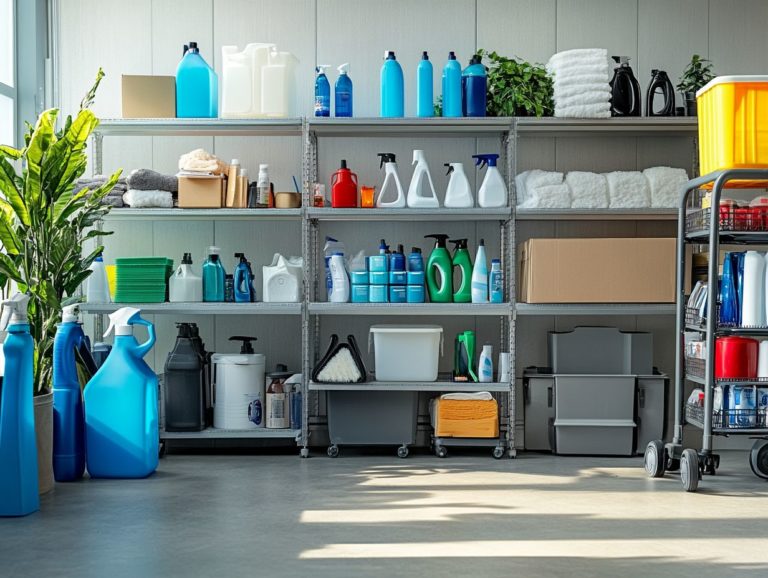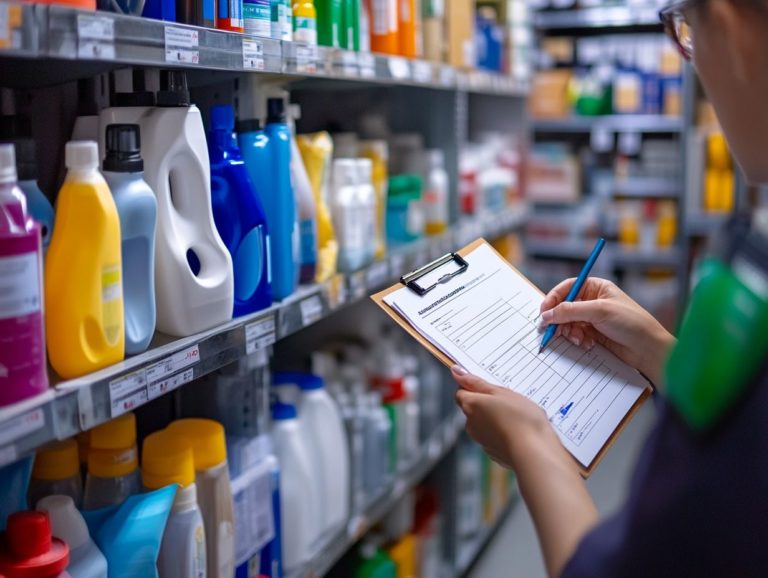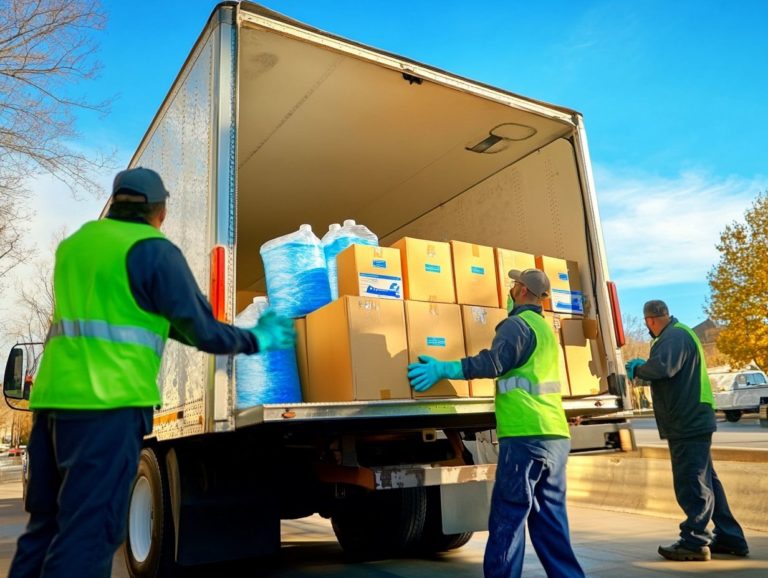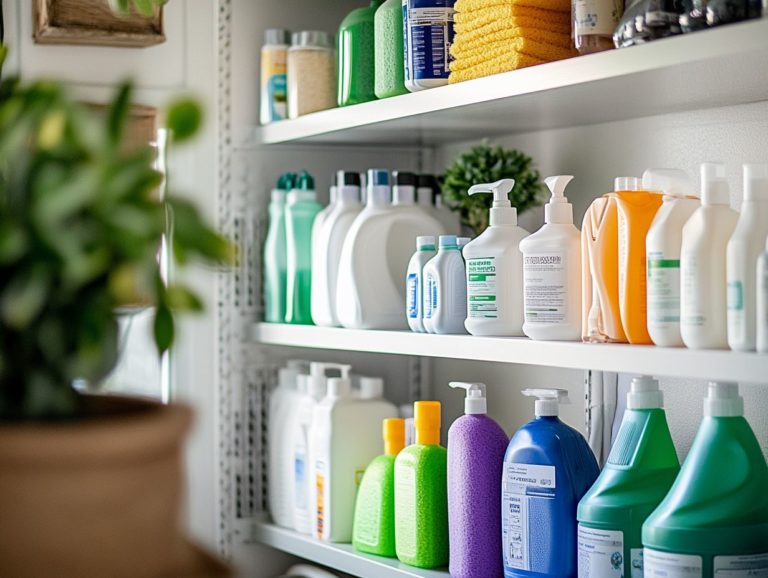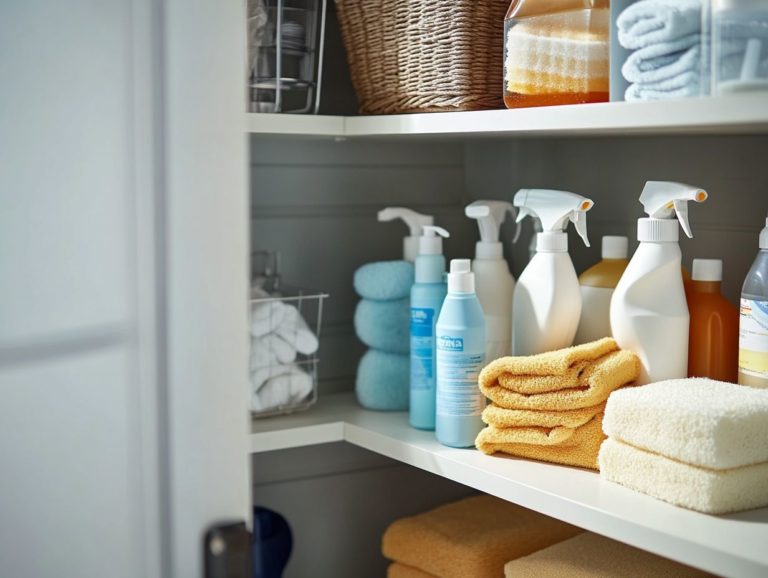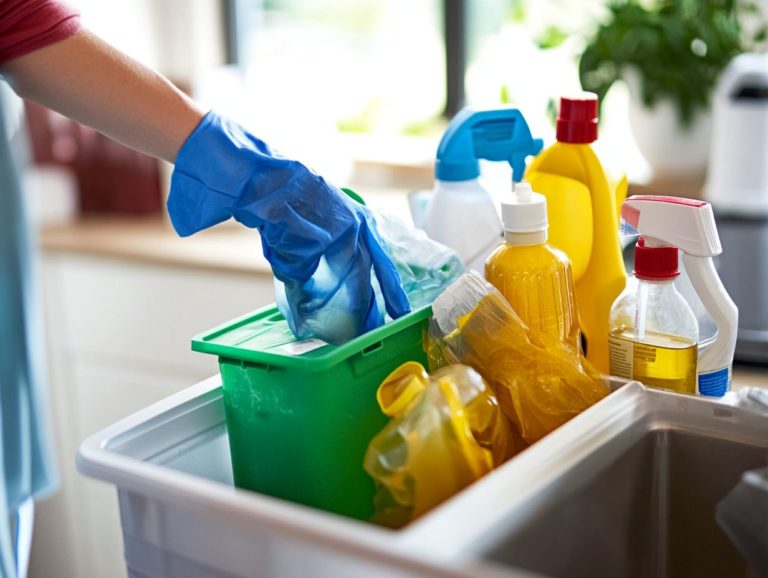How to Avoid Mixing Incompatible Cleaners
Cleaning is a vital aspect of ensuring a healthy and safe home environment. However, it s essential to remember that not all cleaning products are compatible. Mixing incompatible cleaners can trigger hazardous chemical reactions, potentially endangering your health and safety.
This article delves into the concept of incompatible cleaners. It emphasizes the importance of avoiding their combination and provides insights on how to identify them. You ll discover common culprits and explore safer alternatives along with guidance on proper disposal methods.
Prepare to elevate your cleaning game with smarter and safer practices!
Contents
- Key Takeaways:
- What Are Incompatible Cleaners?
- Why Is It Important to Avoid Mixing Incompatible Cleaners?
- How To Identify Incompatible Cleaners?
- What Are The Most Common Incompatible Cleaners?
- What Are The Alternative Cleaning Solutions?
- How To Safely Dispose Of Incompatible Cleaners?
- Frequently Asked Questions
- What are cleaners that shouldn’t be mixed?
- How can you spot incompatible cleaners?
- What are common examples of incompatible cleaners?
- What precautions should you take when handling incompatible cleaners?
- What should you do if you accidentally mix incompatible cleaners?
- What are some safe alternative cleaning options?
Key Takeaways:

- Always check cleaning product labels and ingredients.
- Avoid mixing cleaners to prevent dangerous fumes.
- Dispose of incompatible cleaners safely by following label instructions.
What Are Incompatible Cleaners?
Incompatible cleaners are cleaning products that, when combined, can trigger dangerous chemical reactions. These reactions can generate toxic fumes or hazardous byproducts. Mixing these substances poses serious health risks, including respiratory damage and the potential for accidental poisonings. That s why it’s vital to have a clear understanding of what s in your household cleaners.
Take, for instance, the notorious duo of bleach and ammonia. Their combination produces chlorine gas, a highly toxic substance you definitely want to avoid. Vinegar, hydrogen peroxide, and baking soda can also react dangerously if mixed.
Now that you know about incompatible cleaners, take action to ensure a safer, cleaner home!
Why Is It Important to Avoid Mixing Incompatible Cleaners?
Avoiding the mixing of incompatible cleaners is essential. This practice helps maintain a safe and effective cleaning routine and prevents serious health risks linked to toxic fumes and chemical reactions.
When incompatible cleaning products are combined, they can release harmful gases that threaten your respiratory health. This could even lead to acute poisoning, particularly in poorly ventilated spaces.
The Centers for Disease Control and Prevention (CDC) has documented numerous incidents stemming from the improper use of household cleaners. These incidents highlight the urgent need for awareness and strict adherence to safety guidelines.
Follow these tips to keep your home safe and spark joy in your cleaning routine!
What Are The Dangers of Mixing Incompatible Cleaners?
Mixing incompatible cleaners poses serious dangers, including the risk of producing toxic gases like chlorine gas from the combination of bleach and ammonia. This powerful gas can lead to severe respiratory damage and eye irritation, among other health complications. Similarly, mixing hydrogen peroxide and vinegar can generate harmful byproducts.
Understanding these dangers is essential for preventing hazardous situations in your home. Case studies have showcased the repercussions of improper cleaning product use. For example, a hospital once reported a spike in emergency room visits due to individuals developing respiratory issues after mistakenly mixing cleaners.
The importance of awareness cannot be overstated. Even combinations that seem harmless can lead to violent reactions. Mixing vinegar and hydrogen peroxide can create a strong cleaning agent that can be dangerous if mixed with certain substances. These incidents highlight the crucial need for you to thoroughly understand the chemical nature of household cleaners, ensuring that safety measures are diligently followed to avoid potential health hazards.
How To Identify Incompatible Cleaners?
Identifying incompatible cleaners demands diligence and a keen understanding of the components within household cleaning products, which is essential for maintaining a safe cleaning environment. Start by examining the labels of your cleaning supplies, looking for warnings or instructions that indicate compatibility or incompatibility with other agents.
Familiarizing yourself with common ingredients found in cleaners, such as bleach and ammonia, will empower you to avoid perilous mixtures. You can enhance your knowledge by engaging in online research or consulting safety guidelines.
1. Check The Labels
Checking the labels of cleaning products is an essential step in identifying incompatible cleaners, as manufacturers include crucial safety guidelines and warnings about chemical reactions. You’ll find that labels typically specify the ingredients and offer guidance on what not to mix, helping you steer clear of dangerous combinations.
Paying attention to these details is vital because even products that seem harmless can turn hazardous when combined, such as bleach and ammonia, which create toxic chlorine gas.
Understanding the common phrases on these labels can significantly enhance your safety during household cleaning. Look for symbols indicating harmful effects or potential reactions, like exclamation points or skull and crossbones, which serve as visual warnings.
For instance, if a product states “do not mix with acids,” it s imperative to take that seriously. Phrases like “use in well-ventilated areas” signal the need for extra caution.
By familiarizing yourself with these labels, you can establish a safer cleaning routine that effectively protects your health and home. Start checking your labels today for a safer cleaning experience!
2. Know The Ingredients
Understanding the ingredients in your cleaning solutions is essential to prevent mixing incompatible cleaners that could lead to harmful chemical reactions. Many household cleaning agents, like those containing sodium hypochlorite (the active ingredient in bleach) and ammonia, can generate toxic gases like chlorine gas when combined.
By familiarizing yourself with the chemical makeup of these products, you empower yourself to make informed decisions about the cleaning solutions you use, helping you avoid dangerous mixtures.
Knowing the properties of frequently used ingredients like vinegar, hydrogen peroxide, and baking soda can enable you to create effective, non-toxic cleaning solutions. For example, vinegar acts as an excellent natural disinfectant, while hydrogen peroxide is a powerful stain remover.
However, always check compatibility to avoid potentially harmful reactions; mixing vinegar with bleach, for instance, can produce hazardous chlorine vapors.
Researching these substances can help you clean safely and minimize health risks while maximizing the effectiveness of your cleaning efforts.
3. Research Online
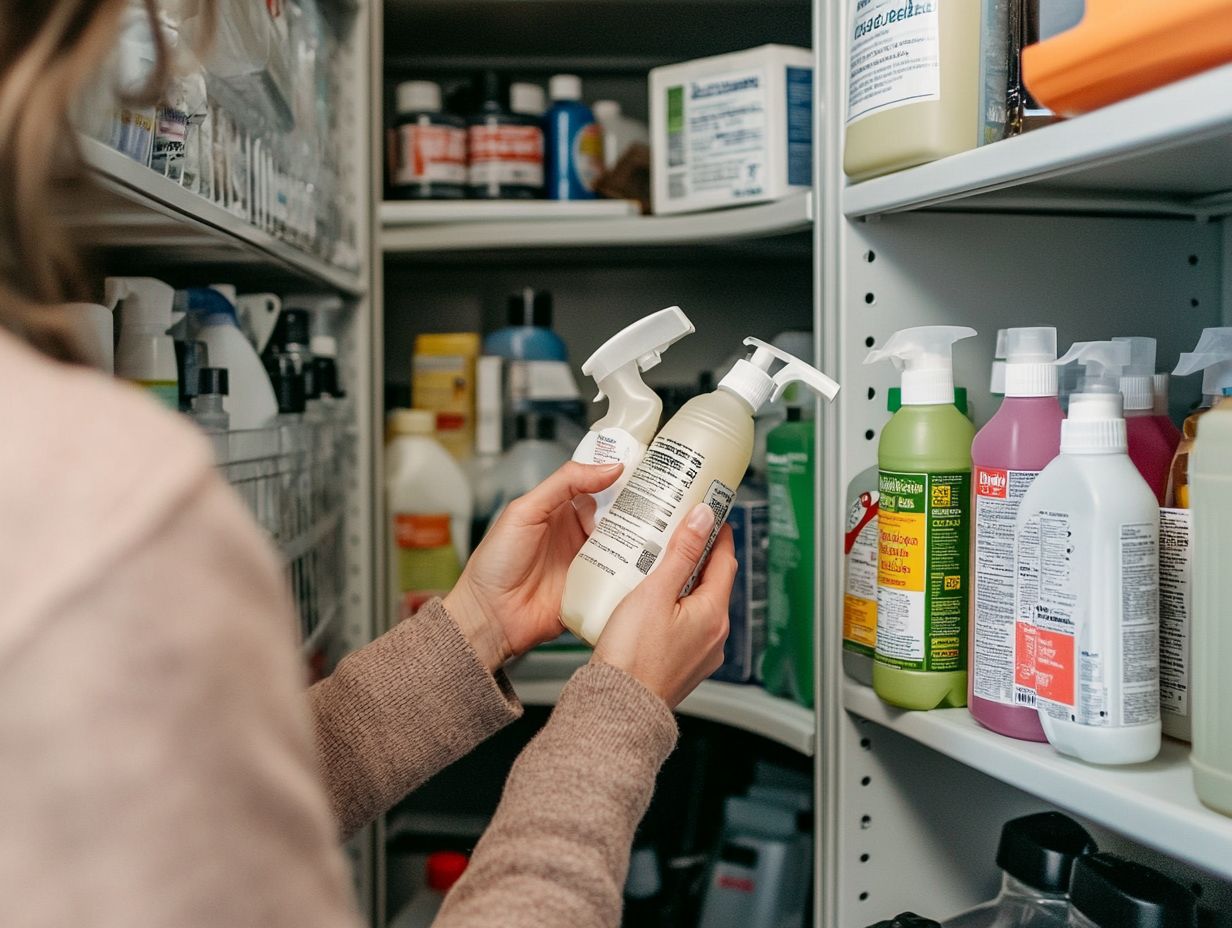
Researching online can be your secret weapon against dangerous cleaners, as numerous resources provide insightful information on common chemical reactions that can arise from mixing certain cleaning products.
Websites belonging to trusted organizations, like the CDC, present guidelines and lists of incompatible cleaning agents, empowering you to make informed and safe choices.
In addition to the CDC, reputable sources like the Environmental Protection Agency (EPA) and safety data sheets (SDS) from manufacturers prove invaluable. These platforms frequently offer comprehensive data about hazardous interactions between cleaning agents, crucial for maintaining a safe household environment.
It s wise to cross-reference information from multiple sources to verify the accuracy of the guidelines, especially since formulations can change over time.
Staying informed about best practices involves regularly checking for new studies or updates, which can help prevent accidents while promoting effective cleaning methods.
What Are The Most Common Incompatible Cleaners?
Be cautious! Several cleaning agents are notorious for being incompatible and can react dangerously when mixed, leading to harmful chemical reactions and potential health risks.
Bleach and ammonia are the most infamous duo, producing toxic chlorine gas that poses serious respiratory hazards. Mixing bleach and vinegar can also create harmful chlorine gas. Furthermore, combining hydrogen peroxide with vinegar risks generating peracetic acid, a potent irritant.
Even the seemingly innocent combination of baking soda and vinegar can lead to vigorous reactions that may cause spills and splashes. This underscores the importance of being informed about these common incompatible cleaners.
1. Bleach And Ammonia
The combination of bleach and ammonia stands out as one of the most dangerous mixtures found in household cleaning products. This reaction is extremely dangerous and can occur quickly, generating toxic chlorine gas that can inflict severe respiratory damage and other serious health issues.
This dangerous chemical reaction occurs when sodium hypochlorite (the active ingredient in bleach) interacts with ammonia, resulting in harmful fumes. These fumes can trigger coughing, shortness of breath, and eye irritation. To ensure your safety and protect your health, it s vital to avoid using these two cleaners simultaneously.
Improper use of these cleaning agents can lead to significant health risks, as noted by the CDC (Centers for Disease Control and Prevention). Prolonged exposure can lead to long-term pulmonary complications and worsen existing health conditions, particularly among vulnerable groups such as children and individuals with asthma.
Reported cases of home poisonings have significantly increased due to the misuse of cleaning products, highlighting the need for proper education on safe cleaning practices.
Create a cleaning routine to avoid accidental mixing. Consider opting for alternatives like vinegar and baking soda for many cleaning tasks, as these natural agents are not only effective but also free from harmful fumes. Many cleaning solutions on the market today are designed to minimize chemical reactions that lead to toxic fumes.
Proper ventilation and the use of protective gear, such as gloves and masks, can further reduce risks when handling these potent cleaning agents. This practice aligns with safety guidelines that emphasize the importance of personal protective equipment to avoid accidental poisonings and exposure incidents.
2. Bleach And Vinegar
Mixing bleach and vinegar is a practice you should absolutely avoid. This dangerous combination releases toxic chlorine gas that can lead to respiratory issues and other serious health problems.
The chemical reaction occurs when the acetic acid in vinegar interacts with sodium hypochlorite in bleach, resulting in the emission of harmful fumes. This reaction becomes especially perilous in poorly ventilated areas, underscoring the necessity of following safety rules when using these common household cleaners.
The CDC warns against mixing any household cleaners containing hydrochloric acid with bleach due to the risk of producing toxic substances. Reports indicate that exposure to chlorine gas can cause coughing, chest pain, and difficulty breathing, with hundreds of emergency room visits each year linked to this hazardous mixture.
According to the National Poison Control Center, incidents related to bleach have seen a troubling rise, primarily due to misunderstandings about the dangers of mixing household cleaners. These incidents often involve accidental poisonings and other exposure incidents requiring immediate medical attention.
Rather than resorting to these risky combinations, you can choose safer alternatives such as:
- baking soda
- hydrogen peroxide
- eco-friendly commercial cleaners
These options effectively disinfect surfaces while minimizing health risks, allowing you to maintain a clean home environment without the threat of toxic fumes. Companies like Maid Bright and Sunrise Industrial Cleaners offer professional services using these safer alternatives, ensuring thorough sanitation without harmful chemicals.
Did you know that mixing common household cleaners can be dangerous? Share this information to help others stay safe!
3. Hydrogen Peroxide And Vinegar
Combining hydrogen peroxide and vinegar is risky. It produces peracetic acid an irritant that can harm your respiratory system and skin.
This hazardous reaction occurs when hydrogen peroxide, a powerful disinfectant, meets the acetic acid in vinegar. The result? A substance that poses serious risks if inhaled or if it touches your skin. Grasping the implications of this reaction is crucial to protecting yourself from this perilous mixture during your cleaning routines. During the Covid-19 pandemic, the misuse of disinfectants and cleaning products led to a rise in exposure incidents, illustrating the importance of understanding chemical reactions.
Peracetic acid can also lead to severe health issues over time, including damage to your eyes and mucous membranes.
Although both hydrogen peroxide and vinegar are champions of cleaning and disinfecting when used on their own hydrogen peroxide is a formidable foe against bacteria and viruses, while vinegar excels at cutting through grease and mineral buildup it’s essential to exercise caution.
Using hydrogen peroxide for sanitizing countertops and vinegar for deodorizing can deliver excellent results without the accompanying risks. Always ensure you have good airflow to stay safe while you clean! The CDC recommends proper usage of these substances to avoid hazardous chemical reactions and ensure effective sanitation.
4. Baking Soda And Vinegar
While baking soda and vinegar often receive accolades as natural cleaning solutions, their combination can lead to some rather vigorous chemical reactions that result in splashing and spills, introducing a different type of hazard to your cleaning routine. When mixed, these two substances generate carbon dioxide gas, creating bubbling and fizzing that can disrupt your efforts and create a mess. Understanding the interaction between these natural ingredients is crucial for ensuring safe and effective cleaning practices. According to the CDC, unintentional mixtures of household cleaners have led to numerous home poisonings and emergency room visits.
To guarantee a safe cleaning experience, it s wise to use baking soda and vinegar separately. For example, sprinkling baking soda on surfaces can effectively absorb odors and loosen grime, while vinegar works wonders at cutting through grease when applied as a spray.
Letting them work separately keeps reactions under control and boosts their cleaning effectiveness, allowing you to achieve a thorough clean without the drama of an explosive mixture.
A little foresight in your cleaning approach can go a long way in maintaining cleanliness while ensuring safety.
What Are The Alternative Cleaning Solutions?
Looking for alternative cleaning products gives you safe and effective ways to clean, all while sidestepping the risks tied to incompatible cleaners. With third-party certification and adherence to safety guidelines, these alternatives provide peace of mind while ensuring thorough sanitation.
One popular strategy is to opt for multi-purpose cleaners, specifically formulated to be safe on a variety of surfaces without the hazards of mixing harsh chemicals. Alternatively, you might consider crafting your own cleaning solutions at home using natural ingredients like vinegar, baking soda, and essential oils. This approach guarantees both safety and effectiveness in your cleaning regimen. Avoiding the use of hazardous chemicals helps in reducing the risk of toxic reactions and contributes to a healthier home environment.
Choosing these alternatives reduces the chances of toxic reactions and leads to a healthier home environment. The CDC and other health organizations advocate for the use of safe cleaning products to avoid accidental poisonings and other health risks linked to mixed cleaning agents.
1. Use A Multi-Purpose Cleaner
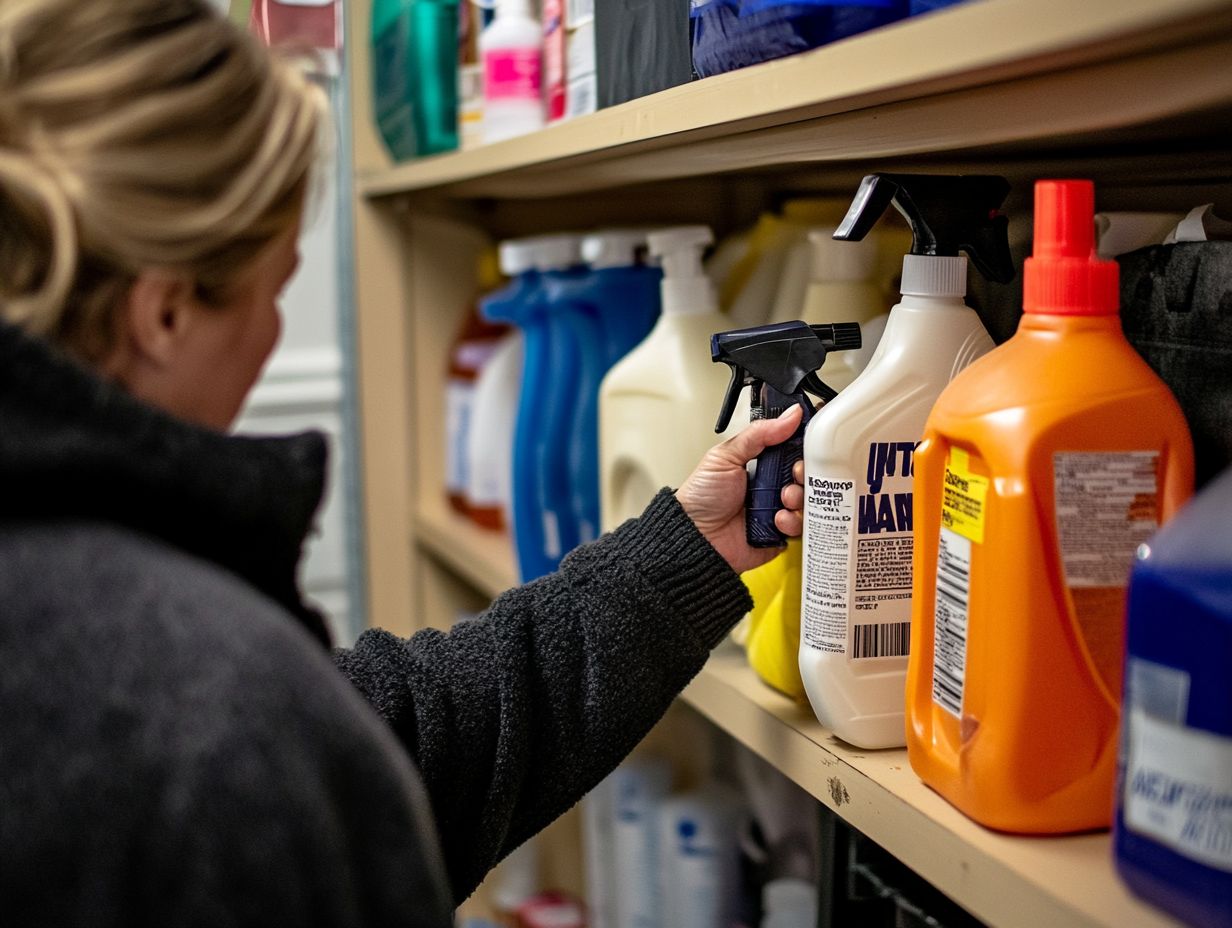
A multi-purpose cleaner serves as a versatile solution that can take on a range of surfaces while minimizing the risks that come with using incompatible products. These cleaners are specially designed to be safe for various surfaces, preventing harmful chemical reactions and making them a smart choice for any household.
By opting for a reputable brand with third-party certification, you can rest assured that the cleaner meets safety standards, significantly reducing the risk of exposure incidents. Brands like Maid Bright and Sunrise Industrial Cleaners offer products that comply with these standards, ensuring effective and safe cleaning.
Using a multi-purpose cleaner can streamline your cleaning routine, saving you both time and effort. When choosing the right product, look for one that clearly lists its ingredients, prioritizes biodegradable options, and steers clear of harsh chemicals.
For optimal results, be sure to follow the manufacturer’s instructions regarding dilution and application methods. Allow the cleaner sufficient contact time to effectively break down dirt and grime. With the right approach, these cleaners can conquer everything from kitchen countertops to bathroom fixtures, making them an critical tool in your cleaning arsenal. This method not only ensures effectiveness but also adheres to safety guidelines, reducing the risk of exposure incidents.
2. Make Your Own Cleaning Solutions
Making your own cleaning solutions lets you customize your approach to cleaning while ensuring the use of safe, non-toxic ingredients free from the harmful chemicals often found in commercial products. With simple household items like vinegar, baking soda, and essential oils at your disposal, you can harness effective cleaning power without the risks associated with chemical reactions.
This approach not only enhances safety but also provides environmentally friendly alternatives to conventional cleaning products. Start crafting your own cleaners today for a safer home! By tapping into the natural properties of these ingredients, you can create multi-purpose cleaners that tackle everything from stubborn stains to greasy countertops.
For example, vinegar serves as a natural disinfectant and deodorizer, making it perfect for cutting through grime while leaving your surfaces fresh. Baking soda acts as a gentle abrasive, ideal for scrubbing without scratching, and essential oils not only introduce delightful fragrances but also boast antimicrobial properties.
However, it’s crucial to keep in mind that not all ingredients get along. Mixing vinegar and baking soda can lead to bubbling reactions that may undermine your cleaning effectiveness, so it’s wise to keep your combinations simple yet impactful. Following expert safety guidelines will ensure that your homemade solutions do not pose any health risks.
3. Use Natural Cleaning Products
Natural cleaning products present an excellent alternative for anyone seeking safe and environmentally friendly solutions for household cleaning. Typically free from harsh chemicals, these products minimize the risk of harmful reactions and significantly reduce overall exposure to toxic fumes. By selecting reputable brands that prioritize sustainability and safety, you can maintain a pristine environment without compromising your health or the well-being of the planet.
Using natural cleaners creates a healthier indoor atmosphere, as they avoid releasing chemicals that can irritate your lungs and throat. When choosing natural cleaning products, it’s crucial to seek out certifications like USDA Organic or EcoLogo, which reflect adherence to stringent standards for environmental safety. Third-party certification ensures that these products are free from harmful chemicals and are safe for use around people with respiratory conditions.
Brands like Seventh Generation and Mrs. Meyer’s offer a diverse array of options tailored to various cleaning needs while ensuring their formulations are biodegradable and non-toxic. Additionally, DIY solutions featuring ingredients such as vinegar, baking soda, and essential oils provide effective cleaning without the environmental footprint associated with conventional products.
How To Safely Dispose Of Incompatible Cleaners?
Safely disposing of incompatible cleaners is essential to prevent environmental contamination and reduce health risks from improper disposal of hazardous materials.
Your first step is to contact your local waste management facility to learn about the specific disposal procedures for cleaning products that may contain toxic chemicals.
It’s crucial to follow the instructions on the product label, as many provide clear guidelines on safe disposal methods. This reduces the risk of accidents and exposure incidents, ensuring you handle these materials responsibly.
1. Contact Your Local Waste Management Facility
Contacting your local waste management facility is vital for the safe disposal of incompatible cleaners and hazardous materials. Many communities offer specific collection events or guidelines for disposing of cleaning products that contain harmful chemicals, helping to protect both the environment and public health.
By reaching out to these facilities, you gain valuable insights on how to handle unwanted cleaning agents responsibly. They often provide locations and schedules for safe drop-off through hazardous waste disposal programs.
Your local municipality may organize biannual hazardous waste collection days, allowing you to bring items like old paint, batteries, and chemical cleaners without worrying about improper disposal.
Community initiatives, such as public awareness campaigns, encourage safe disposal practices and educate you on the risks associated with mishandling toxic materials. By participating in these programs, you contribute to cleaner neighborhoods and foster a culture of responsibility towards sustainability and environmental health.
2. Follow The Instructions On The Label
Following the instructions on the product label is key for safe disposal of household cleaners. Manufacturers provide guidelines to minimize risks associated with hazardous waste, which refers to waste that can harm people or the environment.
These instructions clarify whether a product can be thrown in the regular trash, recycled, or requires special handling due to its toxic components. Adhering to these guidelines ensures your personal safety and protects the environment.
Look for phrases like “hazardous waste,” “dispose responsibly,” or “contact local authorities for disposal.” Understanding these terms empowers you to handle a product correctly after use.
Products labeled as hazardous typically must go to a designated disposal site instead of being thrown in the trash. Following disposal guidelines isn t just a compliance measure; it prevents accidents that could endanger your loved ones or the environment.
By interpreting and following the disposal advice correctly, you help create a safer community and a healthier planet.
3. Do Not Pour Down The Drain
Avoid pouring incompatible cleaners down the drain; doing so can cause serious environmental hazards and plumbing issues. Many cleaning products contain chemicals that can damage aquatic life and degrade water quality, making improper disposal a significant public health concern.
Instead, always seek designated disposal methods that comply with local regulations for safe handling of hazardous waste and to protect the environment.
Improperly mixed cleaners can react violently, producing toxic fumes or even causing explosive reactions that threaten personal safety and lead to costly repairs. These harmful chemicals can accumulate in water systems, endangering fish and other wildlife while disrupting entire ecosystems.
To reduce these risks, utilize local hazardous waste collection centers or community disposal events. Some municipalities even offer curbside pickup for certain cleaners, providing safe alternatives to pouring them down the drain.
By following these disposal practices, you can actively contribute to a healthier environment and help safeguard public health.
Check for local disposal events or reach out to your waste management facility today. Together, we can make a difference in safe disposal practices!
Feel free to share this information on social media to raise awareness about the importance of safe disposal practices.
Frequently Asked Questions
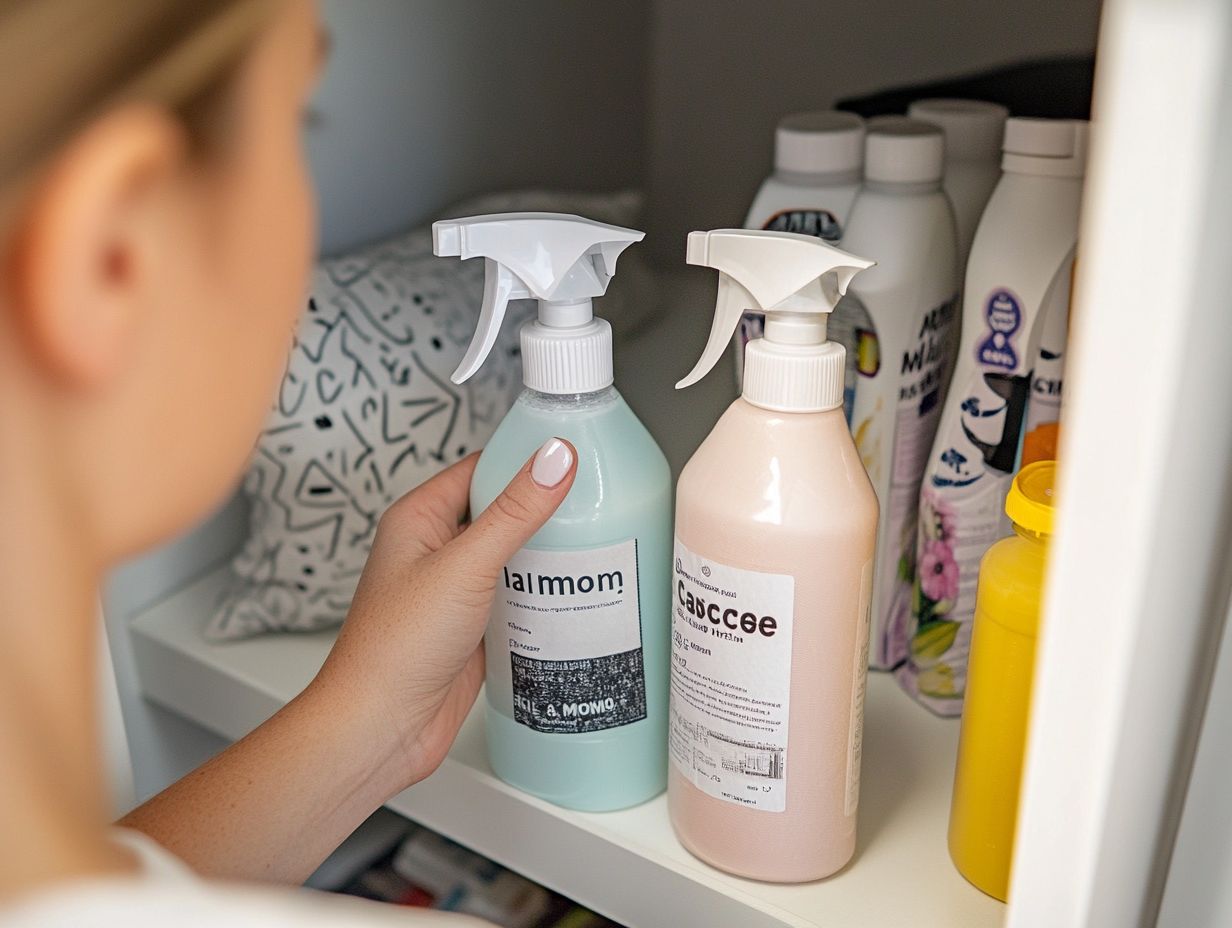
What are cleaners that shouldn’t be mixed?
These are cleaning products that contain different chemicals which can react dangerously when combined. Mixing them can create harmful fumes or even explosions!
How can you spot incompatible cleaners?
Always read the label and ingredients list before using any cleaning product. If you see warnings against mixing, it’s best to avoid using those products together.
You can also research or consult a professional for a reliable list of incompatible cleaners.
What are common examples of incompatible cleaners?
Common examples include bleach and ammonia, bleach and vinegar, or any acidic cleaner (like lemon or vinegar) with an alkaline cleaner (like bleach or ammonia). Mixing these can produce toxic gases such as chlorine or chloramine!
What precautions should you take when handling incompatible cleaners?
Always wear protective gear, like gloves and a mask, when using cleaning products. Work in a well-ventilated area and store incompatible cleaners in separate containers.
If you accidentally mix them, step away from the area and ventilate the room immediately!
What should you do if you accidentally mix incompatible cleaners?
If you mix cleaners by accident, stay calm and act quickly! Step away from the area and ensure ventilation in the room.
If you experience symptoms like difficulty breathing, dizziness, or irritation, seek medical attention right away. Don t try to clean up the mixture yourself!
What are some safe alternative cleaning options?
Natural cleaners like vinegar, baking soda, and lemon juice work well for most household cleaning needs.
You can also choose all-purpose cleaners explicitly labeled as safe to use with other products. Play it safe and stick to one product at a time to avoid dangerous mixtures!
Have you experienced mixing cleaners? Share your tips and experiences to help others stay safe!
